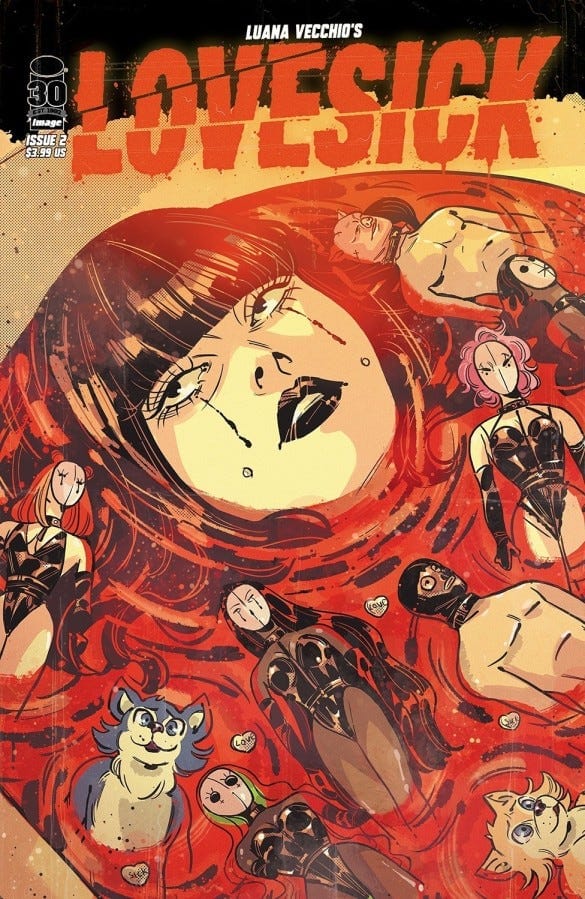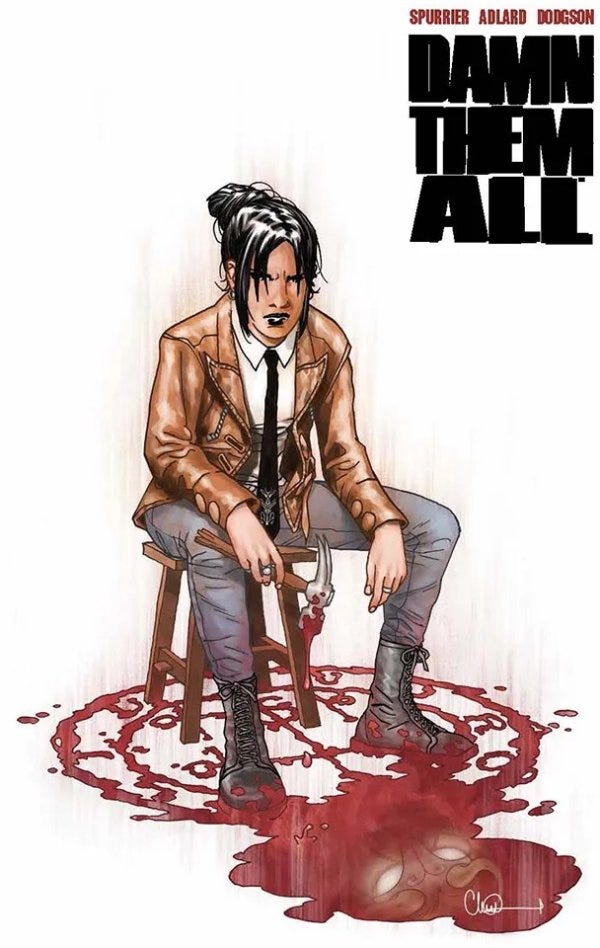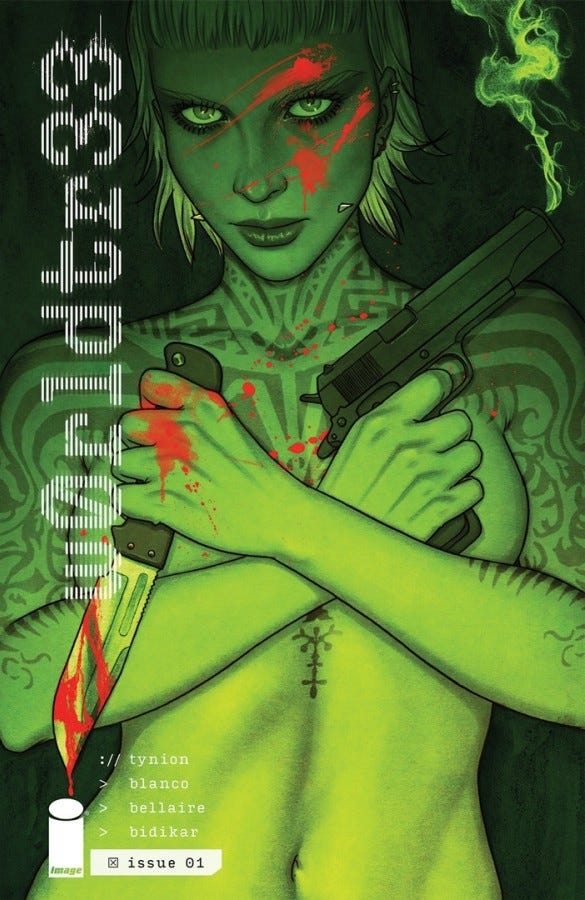Mini-reviews: Damn Them All, W0Rldtr33, Lovesick
I spend so much time excavating comics history that I often neglect to follow what’s happening in the present. So this is the first in what…

I spend so much time excavating comics history that I often neglect to follow what’s happening in the present. So this is the first in what will be a series of collections of “mini-reviews” on more current comics. This time around I’m looking at some fairly mainstream “direct market” comics, but I’ll also dive into WebToons and underground zines.
I’ve also been using the digital comics platform GlobalComix, where you can find many comics published by Image Comics, Boom Studios!, AWA, TKO, Mad Cave and many more. You can check out my “favorites” and my “to read” list there.
Today’s batch of books each tries to deal with the moment that we’re living through in its own way, while also playing a bit to the nostalgia crowd. I think each has something to offer regular readers of this site.

Damn Them All
- Written by Simon Spurrier, illustrated by Charlie Adlard, published by Boom!
Vertigo Comics is now four years gone. But its spirit lives on. There have been plenty of Vertigo-esque books over the years, long before Vertigo was officially discontinued, but Damn Them All is one of the most authentically old school one I’ve seen. It’s rather obviously meant to be a Hellblazer successor. The main character, Ellie Hawthorne, was trained in magic by her uncle “Alfie Hawthorne,” a John Constantine analog whose face we never see. It’s probably the strongest of this batch of books, though it’s not quite my favorite. I definitely recommend it to any fan of 90s Vertigo. Adlard gives the book a look and feel reminiscent of the era.
But it’s not just an exercise in nostalgia. This isn’t about John Constantine, it’s about a new generation and society’s contemporary situation. The plot revolves around someone, somehow having made it possible for anyone to easily summon and control Goetic demons. Gangsters, occult dabblers, politicians, and homeless refugees alike suddenly wield unfathomable power, throwing reality into havoc. Spurrier has a unique spin on demonology that, intentional or not, it serves as a metaphor for the broken state of our post-BREXIT, post-Trump, post-COVID state of reality.
The first TPB was released in August. You can also read every issue on GlobalComix.
- Outlaw Comics taxonomy: This is a mainstream comic by mainstream creators published by a mainstream publisher. It’s certainly more Vertigo than Rebel Studios. But Adlard has some Outlaw cred. He’s best known for Walking Dead, which is very mainstream but also quite bleak and often so over-the-line as to be somewhat disreputable. Perhaps more relevant though is Adlard’s earlier work on The Crow: Wild Justice and Codeflesh. Still, this is at most “Outlaw Adjacent.”

W0Rldtr33
- Written by James Tynion IV, illustrated by Fernando Blanco, published by Image Comics.
Even if Damn Them All is the strongest of these titles, my favorite of this lot is actually W0Rldtr33. Tynion taps into late 90s/early 2000s internet nostalgia, but, like Spurrier, is concerned with the breakdown of our modern consensus reality. In W0Rldtr33, that breakdown is apparently caused by the discovery of the “Undernet,” a possibly supernatural hidden element of the internet that drives people around the world on murder sprees. As more people, largely young men, discover the Undernet, society begins to fray. The story cuts between a group of teenagers who discover the Undernet at some point in the past, probably around the year 2000, and their efforts in the year 2024 to contain it again.
My main complaint is that although it’s a quick read, the ensemble cast doesn’t get much development and the plot doesn’t advance much over the first five-issue story arc, concluding on a rather unsatisfactory cliffhanger ending that promises more to come. It feels more like a pilot episode than a “first volume.” I am, of course, eagerly awaiting more.
The first TPB should be out November 8, in the meantime the first five issues are available in single issues wherever you buy your comics.
- Outlaw Comics taxonomy: Tynion is the man of the moment, selling through print runs and racking up awards faster than I can count ’em. He’s about as reputable a creator as you can imagine at this point in time. But there’s definitely an outlaw quality to this book, even if it is one of Image’s top sellers. I mean, there’s a woman who never wears clothes who goes around killing people with no compunction. Glen Hammonds would have loved this book. Let’s file it under “Post-Outlaw Comics.”
Lovesick
- Written and illustrated Luana Vecchio, published by Image Comics.
Like W0Rldtr33 and Ed Piskor’s Red Room, Lovesick deals with, well, red rooms, the probably fictitious live-streaming torture and snuff videos of the dark web. The story revolves around a woman named Domino, who runs Red Rooms and publishes snuff films featuring young men who have volunteered to be tortured and killed by her. Some revere her as a goddess. Others, including an incel group called the “Bloodcels,” see her as a demon. Vecchio’s art is great, and the text pieces in the back demonstrate that she wrestled with the implications of her work, such as whether she was glorifying or normalizing the sorts of degradations and violence she portrayed, in a way that too few outlaw comics artists have.
Ultimately, though, I found the story unsatisfying. By the end it becomes less about Domino herself and more about her relationship with a cannibal/dom named Jack. But I do look forward to reading her other major creator-owned project, Bolero, and any other future work she does.
The TPB collecting the whole series was released in July.
Outlaw Comics taxonomy: This is the most “Outlaw” of this batch of comics. Image is a reputable company, but this started out as a self-published digital comic. It feels like a better-executed version of a Boneyard book, and the fever dream dialog (dialectic?) at the end about freedom, consent, control, and love reminds me a lot of the later issues of Faust. I’d say we can file it under “Outlaw Revival.”